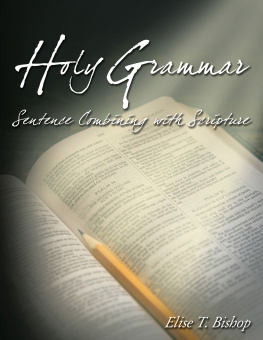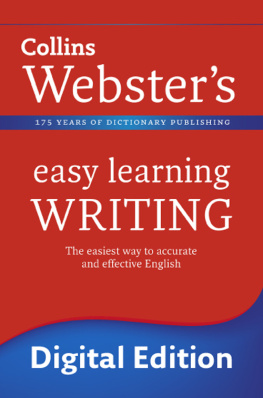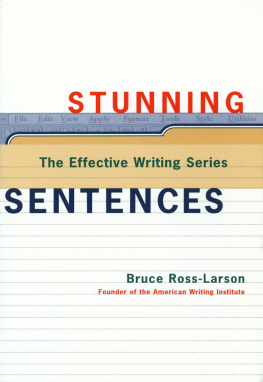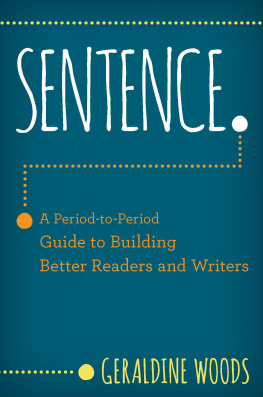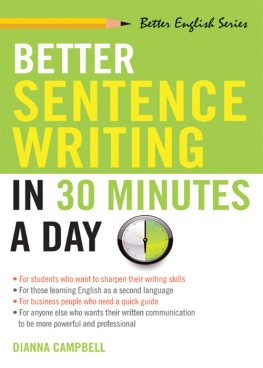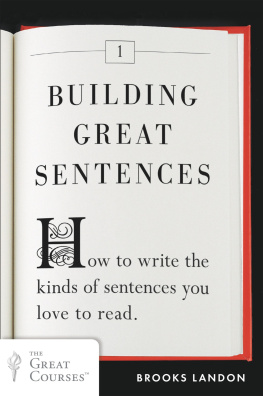Better Sentence-Writing In 30 Minutes a Day
By
Dianna Campbell

Copyright 1994 by Harper Collins College Publishers Trade edition published 1995 by The Career Press, Inc.
All rights reserved under the Pan-American and International Copyright Conventions. This book may not be reproduced, in whole or in part, in any form or by any means electronic or mechanical, including photocopying, recording, or by any information storage and retrieval system now known or hereafter invented, without written permission from the publisher, The Career Press.
B ETTER S ENTENCE -W RITING IN 30 M INUTES A D AY
Cover design by The Visual Group
Printed in the U.S.A. by Book-mart Press
To order this title, please call toll-free 1-800-CAREER-1 (NJ and Canada: 201-848-0310) to order using VISA or MasterCard, or for further information on books from Career Press.
Library of Congress Cataloging-in-Publication Data
Campbell, Dianna S., 1949
Better sentence-writing in 30 minutes a day / by Dianna Campbell.
p. cm.
Includes bibliographical references and index.
ISBN 1-56414-203-5 (paper)
1. English-languageSentences. 2. English languageRhetoric. I. Title.
PE1441.C27 1995
428.2dc20
95-22181
CIP
Contents
Preface
Better Sentence-Writing In 30 Minutes a Day is a workbook for students who have thought seriously about how important it is to improve the technical aspects of their writing. Learning to write well is nothing less than acquiring the power to succeedin school and in the world that lies beyond school. Developing solid writing skills is not a matter of luck; its a matter of hard work and practice.
This book features a basic sentence-combining approach, which means that the emphasis is not merely on learning to avoid errors, but also on learning to create good sentences with variety and style. The book also features:
Clear discussions of rules and strategies for good writing.
Concise explanations with a minimum of grammatical terms.
An abundant variety of exercises, from filling-in-the-blank for purposes of identifying the parts of speech to combining short sentences into longer and more graceful combinations.
An answer key at the end of the book to allow students to work at their own pace and check their work as they go.
Students learn best when they are actively engaged in the learning process. They appreciate exercises that teach them the writing skills they need and entertain or inform them at the same time. That is why this book uses a variety of interesting topics in the exercises. Similarly, the instructional material here is brief, but extensive examples and illustrations are provided.
Using Better Sentence-Writing In 30 Minutes a Day will help students become skillful and confident writers.
Dianna Campbell
Chapter 1
Introduction to Sentence Structure
1.1 Basic Clause Patterns
Some college students can define a sentence, and some cant, but no doubt you know a sentence when you see one. Read the following choices and circle the letter of the one that is a sentence.
(a) Noses entire peoples throughout grow lives their.
(b) Their grow lives throughout peoples noses entire
(c) Grow lives their peoples entire throughout noses.
(d) Peoples noses grow throughout their entire lives.
Each of the four sentences contains the same words, but only one makes sense(d). Sequence (d) makes sense because the words in it are arranged in the form of a sentence. Your ability to recognize the sentence shows how natural the sentence pattern is and how much intuitive language skill you already have.
Simple SentencesThose with One Clause
In order to make good sentences and avoid making errors, we need to develop a basic working definition of a sentence.
Sentences are made up of clausessometimes one clause, sometimes more than one. This chapter focuses on simple sentencesthose that contain one clause. Later, youll work with sentences that contain more than one clause.
A clause is a subject plus a predicate. The subject of a clause names something, such as a person, object, place, or idea. The subject is usually one or more nouns or pronouns. The subject might also be a noun substitute.
The predicate makes a statement about the subject by telling something about it. The predicate tells one of two things about the subject: It tells that the subject is performing an action, or it states the condition of the subject.
Finding Verbs in Clauses
The easiest way to analyze a clause is to look first at the predicate. The most important part of the predicate is the verb.
1. Action VerbsVisible and Invisible
You probably know that most verbs show some kind of action. Sometimes this is visible action, as in she swims or they kissed. At other times, it is invisible action, as in he forgot or we decided.
The verb in our original example sentence shows visible action. Draw a line beneath the verb and write above it.
Peoples noses grow throughout their entire lives.
If you identified grow, youre correct. Thats the word that shows the visible action of the subject. Whats the subject doing? In this sentence, its growing.
2. Linking Verbs
Other verbs, such as is and seem, dont show an action; instead, they show a subject to be in a certain condition or state of being. They do this by linking the subject to a word or words in the predicate. These verbs are linking verbs.
Lets look at two example sentences:
The woman is an intern.
The students seem confident.
In these sentences, the woman and the students are not performing actions, but they are in a state of being or a condition. We might say that, in the first case, the woman is in the state of being an intern and, in the second case, the students are in the condition of being confident.
There are many linking verbs, such as additional tenses of the verb to be (am, are, was, were, will be, has been, have been, had been, and others) and various forms of the verbs appear, become, feel, look, smell, sound, and taste.
3. The Role of Context
Some verbs are action verbs in one context and linking verbs in another. In sentence (a), is the italicized verb describing an action or a condition?
(a) I smelled the familiar fragrance of Chanel No. 5 in the living room.
In (a), the verb from smelled is describing an action, the action of the subject (I) smelling. Now notice the very different meaning of the same word in sentence (b).
(b) The rotten chicken smelled terrible.
In (b), the subject (chicken), is not performing an action. The verb in (b) shows that the chicken is in a certain conditionthe condition of smelling bad.
Finding Subjects in Clauses
Lets return again to our original example sentence:
Peoples noses grow throughout their entire lives.
To find the subject, simply ask yourself, What grows? Noses. The word noses is the simple subject or the key word within the complete subject. The complete subject of any sentence is the simple subject or key word plus all the modifiers attached to it.


